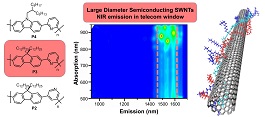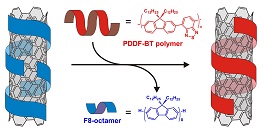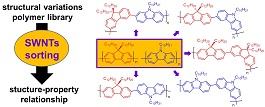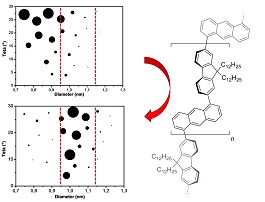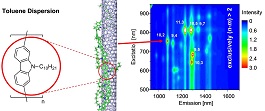Polymer - Carbon Nanotube Interactions
Our research is focused on the design and synthesis of polymers displaying specific interactions with SWNTs allowing their solubilization, purification and sorting.
Single-Walled Carbon Nanotubes exhibit outstanding physical and chemical properties, making them excellent candidate in a wide range of applications including electronics, photonic, sensors and energy conversion. Up to now, SWNT production processes are not selective, neither in chirality nor in electric behavior. Their applications are deeply correlated to this issue as device performances are strongly affected by SWNTs purity. Therefore post-processing approach including sorting of SWNTs is compulsory for their integration as active component in devices. Polymer wrapping is a non-destructive selective method using non-covalent and specific interactions that allows an efficient and scalable process for sorting SWNTs.
This research topic is conducted in close collaboration with the groups of Prof. Manfred M. Kappes (physico-chemistry) and Prof. Wolfgang Wenzel (Nanoscale Simulation).
Overview of our work on polymer assisted sorting of SWNTs:
|
Small 2014, 10, 360–367. Link |
This article describes the extraction of large diameter PLV SWNTs by using several pyridine containing copolymers. We were able to extract exclusively semiconducting SWNTs by using a very simple and scalable method without the need of further separation technic. The emission of these SWNTs is located in NIR region at around 1550 nm which fits with telecom windows, making potential applications in this field. Furthermore, a hybrid model performing at geometrical and DFT levels was successfully developed to get insight into the selection processes. |
|
Chem. Comm. 2012, 48, 2516–2518. Link |
In this communication, we investigated the solubilization ability and selectivity of discrete oligofluorenes toward SWNTs. We were able to identify the required minimum length of oligomers to suspend SWNTs. We further used the lability of the oligomers to demonstrate the concept of polymer exchange, potentially useful for orthogonal sorting. |
|
Macromolecules 2012, 45, 713–722. Link |
In this full paper, we extensively studied a polymer library comprising homo- and co-polymers of fluorene and carbazole building blocks with a 2,7 or 3,6 connectivity as well as other aromatic building blocks. Large differences were observed in the solubilization efficiency as well as in the selectivity, and some general trends regarding structure-property relationship could be extracted.
|
|
Chem. Mater. 2011, 23, 2237–2249. Link |
This full paper describes a series of copolymers containing 9,9-didodecylfluorene and/or N-decylcarbazole and planar aromatic building blocks which were synthesized by Suzuki coupling using dibromides. Ditriflates was also used as pseudo-halid and showed their usefulness for such transformation. The different building blocks were chosen to favor a helical wrapping around the SWNTs. Among these polymers, poly(9,9-didodecylfluorene-2,7-diyl-alt-anthracene-1,5-diyl) showed interesting features with an extraction threshold at 0.95 nm diameter, thus selecting tubes with higher diameter, irrespective of the chiral angle. Furthermore, we reported selective extraction of semiconducting large diameter SWNT of 1.3 nm diameter using a further ultracentrifugation step. |
|
Chem. Commun. 2011, 47, 7428–7430. Link |
In this communication we described the concept of selective sorting of SWNTs and their release triggered by light irradiation. We have engineered a copolymer comprising a (poly)-fluorene as recognition template and an o-nitrobenzyloxy moiety acting as photocleavable group. We were able to identify the optimal fluorene to photocleavable group ratio to enable selective sorting of semiconducting close to armchair SWNTs and their light triggered release. We succeeded to partially remove the polymer as it was degraded into smaller pieces. |
| J. Am. Chem. Soc. 2011, 133, 652–655. Link | Our first paper on SWNTs sorting: we demonstrated that poly-N-decylcarbazole sorts semiconducting SWNT as its parent poly-dioctylfluorene. Nevertheless, SWNTs extracted by the polycarbazole have a chiral angle ranging from 10<theta<20, whereas polyfluorene extracts close to armchair SWNTs (theta>25°). MD simulations were further employed to model both hybrid SWNT/polymer systems. |

